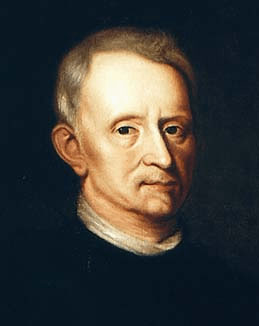| Robert Hooke  Born: 18-Jul-1635 Born: 18-Jul-1635
Birthplace: Freshwater, Isle of Wight, England
Died: 3-Mar-1703
Location of death: London, England
Cause of death: unspecified
Remains: Buried, St. Helen Churchyard, Bishopsgate, London, England
Gender: Male
Race or Ethnicity: White
Sexual orientation: Straight
Occupation: Scientist Nationality: England
Executive summary: Law of Elasticity, microscopist English experimental philosopher, born on the 18th of July 1635 at Freshwater, in the Isle of Wight, where his father, John Hooke, was minister of the parish. After working for a short time with Sir Peter Lely, he went to Westminster School; and in 1653 he entered Christ Church, Oxford, as servitor. After 1655 he was employed and patronized Robert Boyle, who turned his skill to account in the construction of his air-pump. On the 12th of November 1662 he was appointed curator of experiments to the Royal Society, of which he was elected a fellow in 1663, and filled the office during the remainder of his life. In 1664 Sir John Cutler instituted for his benefit a mechanical lectureship of £50 annually, and in the following year he was nominated professor of geometry in Gresham College, where he subsequently resided. After the Great Fire of 1666 he constructed a model for the rebuilding of the city, which was highly approved, although the design of Sir Christopher Wren was preferred. During the progress of the works, however, he acted as surveyor, and accumulated in that lucrative employment a sum of several thousand pounds, discovered after his death in an old iron chest, which had evidently lain unopened for above thirty years.
Hooke fulfilled the duties of secretary to the Royal Society during five years after the death of Henry Oldenburg in 1677, publishing in 1681-82 the papers read before that body under the title of Philosophical Collections. A protracted controversy with Johannes Hevelius, in which he urged the advantages of telescopic over plain sights, brought him little but discredit. His reasons were good; but his offensive style of argument rendered them unpalatable and himself unpopular. Many circumstances concurred to embitter the latter years of his life. The death, in 1687, of his niece, Mrs. Grace Hooke, who had lived with him for many years, caused him deep affliction; a lawsuit with Sir John Cutler about his salary (decided, however, in his favor in 1696) occasioned him prolonged anxiety; and the repeated anticipation of his discoveries inspired him with a morbid jealousy. Marks of public respect were not indeed wanting to him. A degree of M.D. was conferred on him at Doctors' Commons in 1691, and the Royal Society made him, in 1696, a grant to enable him to complete his philosophical inventions. While engaged on this task he died, worn out with disease, on the 3rd of March 1703 in London, and was buried in St. Helen's Church, Bishiopsgate Street.
In personal appearance Hooke made but a sorry show. His figure was crooked, his limbs shrunken; his hair hung in dishevelled locks over his haggard countenance. His temper was irritable, his habits penurious and solitary. He was, however, blameless in morals and reverent in religion. His scientific achievements would probably have been more striking if they had been less varied. He originated much, but perfected little. His optical investigations led him to adopt in an imperfect form the undulatory theory of light, to anticipate the doctrine of interference, and to observe, independently of though subsequently to F. M. Grimaldi (1618-1663), the phenomenon of diffraction. He was the first to state clearly that the motions of the heavenly bodies must be regarded as a mechanical problem, and he approached in a remarkable manner the discovery of universal gravitation. He invented the wheel barometer, discussed the application of barometric indications to meteorological forecasting, suggested a system of optical telegraphy, anticipated E.F.F. Chladni's experiment of strewing a vibrating bell with flour, investigated the nature of sound and the function of the air in respiration and combustion, and originated the idea of using the pendulum as a measure of gravity. He is credited with the invention of the anchor escapement for clocks, and also with the application of spiral springs to the balances of watches, together with the explanation of their action by the principle Ut tensio sic vis (1676).
His principal writings are Micrographia (1664); Lectiones Cutlerianae (1674-79); and Posthumous Works, containing a sketch of his "Philosophical Algebra", published by R. Waller in 1705.
Father: John Hooke (minister)
High School: Westminster School
University: Oxford University
Professor: Professor of Geometry, Gresham College (1665-)
Royal Society 1663
Died Intestate
Author of books:
Micrographia (1665)
Requires Flash 7+ and Javascript.
Do you know something we don't?
Submit a correction or make a comment about this profile
Copyright ©2019 Soylent Communications
|